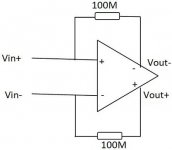Good day, all
I have designed a 2 stage differential input and differential output op-amp with gain close to 45dB and phase margin of 60 degrees. I am trying to connect it as voltage follower based on Op Amp Voltage Follower Uses to check its response for a step input. I am connecting a large resistor between the (+)input and (-)output and vice versa. With VDD = 0.9V and VSS = -0.9V, and differential input 200mV, I am expecting the same differential output voltage.
However, I get an amplified output voltage (Almost -0.8V to +0.8V). I checked that the op-amp is not getting saturated. What am I missing? I want to check what time the output takes to settle.
Any ideas? Thanks a lot!
I have designed a 2 stage differential input and differential output op-amp with gain close to 45dB and phase margin of 60 degrees. I am trying to connect it as voltage follower based on Op Amp Voltage Follower Uses to check its response for a step input. I am connecting a large resistor between the (+)input and (-)output and vice versa. With VDD = 0.9V and VSS = -0.9V, and differential input 200mV, I am expecting the same differential output voltage.
However, I get an amplified output voltage (Almost -0.8V to +0.8V). I checked that the op-amp is not getting saturated. What am I missing? I want to check what time the output takes to settle.
Any ideas? Thanks a lot!
Attachments
I am sorry, but I cannot make sense of your design.
What opamp do you use with two outputs?
Or are you assuming a more complex circuitry than depicted in your schematics?
Cheers,
Martin
What opamp do you use with two outputs?
Or are you assuming a more complex circuitry than depicted in your schematics?
Cheers,
Martin
The fully differential opamp pretty much works as a pair of inverting opamps. The voltage follower only works for non-inverting.
See https://www.ti.com/lit/an/sloa099/sloa099.pdf
See https://www.ti.com/lit/an/sloa099/sloa099.pdf
Good day, all
I have designed a 2 stage differential input and differential output op-amp with gain close to 45dB and phase margin of 60 degrees. I am trying to connect it as voltage follower based on Op Amp Voltage Follower Uses to check its response for a step input. I am connecting a large resistor between the (+)input and (-)output and vice versa. With VDD = 0.9V and VSS = -0.9V, and differential input 200mV, I am expecting the same differential output voltage.
However, I get an amplified output voltage (Almost -0.8V to +0.8V). I checked that the op-amp is not getting saturated. What am I missing? I want to check what time the output takes to settle.
Any ideas? Thanks a lot!
It should work if you use a series resistor at each input (say a few k) and connect the inputs and outputs as you show but instead of 100Meg use much smaller like 100 ohms.
Jan
Thanks again!
Here I cannot short the input to output directly in case of differential input and differential output amplifier right? Usually the gain of fully differential amplifiers is determined by the (two identical) input resistors Rg and the (two identical) feedback resistors Rf. A = Rf/Rg.
Without Rg (in schematic) gain can not be determined.
Here I cannot short the input to output directly in case of differential input and differential output amplifier right? Usually the gain of fully differential amplifiers is determined by the (two identical) input resistors Rg and the (two identical) feedback resistors Rf. A = Rf/Rg.
Without Rg (in schematic) gain can not be determined.
Are those feedback resistors actually 100 MΩ. That could explain why the circuit is cranky. Try something more reasonable like 10-100 kΩ.
Tom
Tom
- Home
- Amplifiers
- Chip Amps
- Op Amp voltage follower settling time
